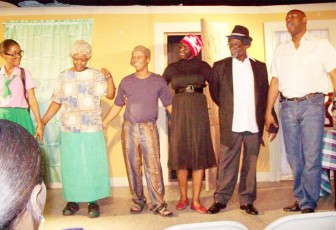The recent performance of the Jamaican play Ova Mi Dead Body by Paul Beale was a very timely intervention where the state of Caribbean theatre is concerned. It has much to say about the rise of the popular theatre and its significant place in contemporary drama of the region. It raises issues of recent trends in the popular theatre and what the meaning of these trends is, including the serious inclusion of the audience in theatre that is built on a great deal of laughter.
Paul O Beale’s play was produced by Stages, an extremely successful performance company in Jamaica that is both product and producer. It has been pushed and directed by the most popular trends and, by its practices and performances also contributes to pushing and deepening these trends. What Stages has done is make an alert commercial response to the demands of the popular audience and, at the same time, produce things that would hold and increase audience interest. It is therefore helping to create more dramatic strategies that appeal to the popular audience.
 These are the things that make Stages a leading popular theatre company in Jamaica. It is a touring company because of the nature of Jamaican theatre at the moment, which has to do with the close relationship between theatre and the grassroots. Plays are taken to various parts of the countryside, attracting amazingly large audiences outside of Kingston, Montego Bay, and the country’s other major urban centres. There is a widespread demand for the popular roots play. The performance of the play in Guyana was one of the contributions of Digicel to the recent National Drama Festival. A festival can be a virtual workshop in drama, exposing audiences to different forms. Stages demonstrated Jamaican roots theatre as well as the most recent developments in this type of popular play. The Guyanese audience was thoroughly entertained, but the performance also exhibited elements of interest.
These are the things that make Stages a leading popular theatre company in Jamaica. It is a touring company because of the nature of Jamaican theatre at the moment, which has to do with the close relationship between theatre and the grassroots. Plays are taken to various parts of the countryside, attracting amazingly large audiences outside of Kingston, Montego Bay, and the country’s other major urban centres. There is a widespread demand for the popular roots play. The performance of the play in Guyana was one of the contributions of Digicel to the recent National Drama Festival. A festival can be a virtual workshop in drama, exposing audiences to different forms. Stages demonstrated Jamaican roots theatre as well as the most recent developments in this type of popular play. The Guyanese audience was thoroughly entertained, but the performance also exhibited elements of interest.
Ova Mi Dead Body is a good example of many of these trends and some of what may be regarded as newer developments in the popular play, and particularly in roots theatre. The kind of performance demonstrated is entertainment, highly developed to amuse. Laughter is one of its main components and is therefore built in to strategies of dialogue, characterisation, social and political references and styles of acting.
Overall, the style was farce, but not given to nearly as much slapstick as has been a staple diet of roots plays. This farce involved a few riotous and hilarious antics, but was mainly a style of delivery in which actors shot many lines for popular and amusing audience consumption. These were often directed straight at the audience even though they were not soliloquies. It was high energy all round, in the pace of the action as well as in this very vocal form defined by speech but accompanied by strangely appropriate body language, sometimes true to character, but always aimed at evoking laughter. The style is therefore very audience-oriented.
The actors are versed in ad-lib, spontaneity and improvisation. This ability has been developed to a very high art by actors in these companies and was sharply illustrated in a performance of Bashment Granny in Guyana. There was a sudden black-out in the middle of a scene when the stage went dark for a moment and then was barely lit only by an emergency lamp for a little while. The Jamaican actors were totally unphased and hardly missed a beat. They continued performing for the two or three minutes of darkness with inventiveness and banter with the audience until full light returned. That reflected their training in ad lib, spontaneity and improvisation.

In Ova Mi Dead Body this was put into practice. It has become a feature of the popular play in Jamaica that actors interact directly with members of the audience. They take on and respond to hecklers, or any chance audible remark from any of them. While they are prepared to react in this way whenever there is an opportunity, they do not wait, but initiate the interaction themselves. True to form, in Ova Mi Dead Body whenever there was a soliloquy it was turned to audience engagement with various types of by-play and picong. Actors occasionally became stand-up comedians in this picong and in the way they addressed the audience.
Topical references and satire are common in these plays and they were present in Paul Beale’s drama. Obviously the actors did some amount of research into the Guyanese setting and found a number of references to the local political situation guaranteed to amuse the audience. They also drew on satire, another important element in the Caribbean popular theatre tradition.
Another interesting element in this style of farce was the subtle uses of parody in the play. Occasionally there was a take-off on the musical form of drama, the Broadway musical or even the opera. It was sophisticated mock-epic resembling the eighteenth century opera in British theatre. Popular songs were used to express emotions or to comment on a situation.
While the parody is a recent development, one of the most interesting returns to this form of theatre was seen in the use of roots theatre and its strategies for fairly serious social commentary. Ova Mi Dead Body has many elements of the classical comedy and seems to show that roots theatre is not necessarily always or purely slapstick and triviality, somewhat contradicting what is to be seen in so many of the specimens. The play presents dramatic conflict based on what is a particularly working class situation. The issues derive from this context. It highlights the pressures on a working class woman, a single mother whose partner is in jail.
She has several issues in her struggle to earn money and maintain a teenage daughter while putting in the effort to keep her in school and on a straight moral path. She comes up against exploitative and unkind relatives as the play comments on domestic violence, child abuse, migration, the demand for the US visa and the practice of many people spending some time working in America to earn what they could hardly earn in Jamaica. There is even a curious treatment of marriage. The main female antagonist values marriage because of the rights of the woman, but rights mean all that she can get from it and the material demands she can make on her husband. The heroine of the play, while in financial need, had no such grasping thoughts and when she did marry her ‘child father,’ it was out of more unselfish considerations. Ironically, she stressed several times throughout the play the benefits of the independent woman, and was prepared to work for money. In the end, she was the winner of property and financial stability accruing from the estate of her husband when he dies suddenly.
As a comedy, Ova Mi Dead Body works in the classical sense. The heroine and her daughter enjoy a happy ending, the ‘covitious,’ back-biting relatives are brought to humility, if not entirely reformed, and her former partner who escaped from prison, is reprieved through the courts. Interestingly, there is a character who appears as a kind of choric ‘property man,’ reappearing as a lawyer and as the probation officer and social worker.
These are fairly new dramatic developments in a popular theatrical form not always taken seriously. What is not very well known in these popular plays is the meaning of some of their popular and hilarious techniques. Some of them are contemporary returns to the grassroots, folk and traditional theatre that developed in the Caribbean after emancipation and flourished in the early twentieth century before fading in mid-century. As theatre was popularised in the region, they then began to reappear among members of the popular audience whose roots and ancestry are to be found in those traditions.








